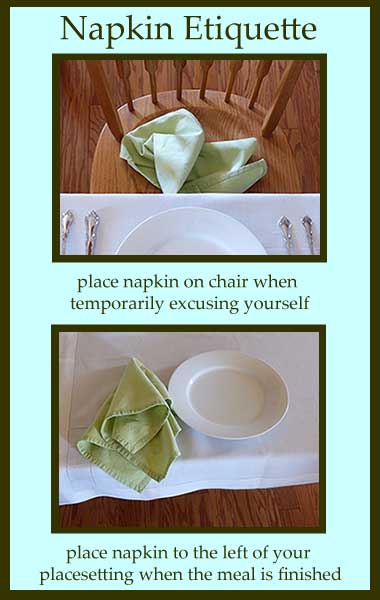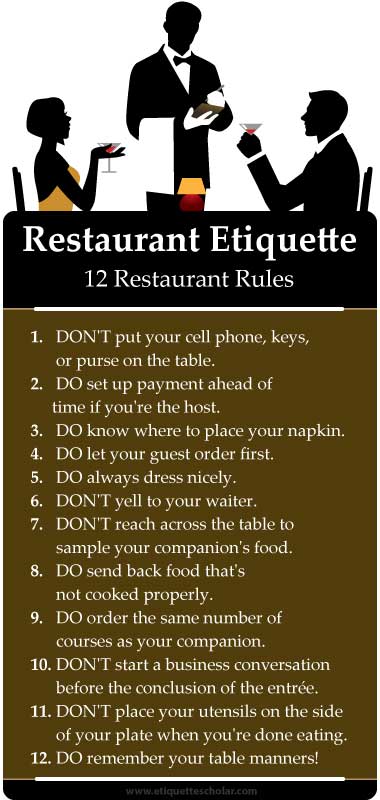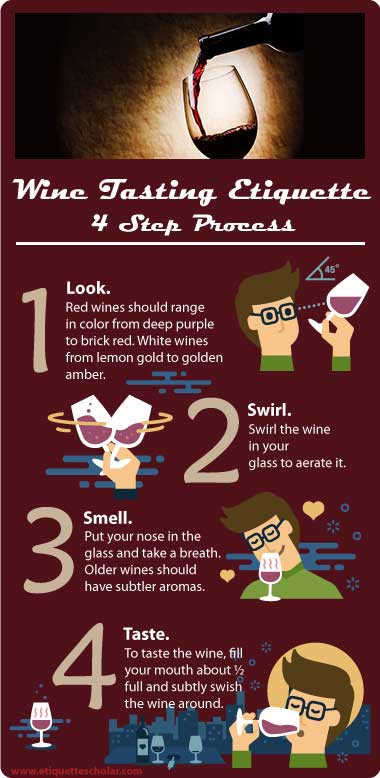Table Etiquette
Restaurant Dining Etiquette
In all but the most informal restaurants, good manners require that you observe a number of civilities and procedures, from the proper use of your napkin and buttering your bread to enjoying your coffee and dessert.
Napkin Etiquette
Put your napkin in your lap shortly after you sit down. As you use it, blotting or patting your lips is preferable to a washcloth-style wipe and remember that this square cloth should never do double duty as a handkerchief.
When the meal is finished, traditional etiquette says you shouldn't place your napkin on the table until the host or hostess has done so, signaling the meal's end. The practice is largely obsolete, but remembering it may come in handy if you're in a group that leans toward formality. In any event, leave the napkin to the left of the setting in loose folds, positioned so that any dirty part is out of sight.
Bread and Butter Etiquette
If you want a piece of bread and the bread basket is close to your place setting, it's perfectly fine to pick up the basket and ask, "Bread, anyone?" After everyone has been served, pick out a piece and put it on your bread plate, along with a pat or two of butter. If the butter comes in a dish, use your butter knife to scoop out a portion to deposit on the edge of the bread plate. (The bread plate is also the place to put jam or jelly, as well as any finger foods served on a communal platter.) Once you've taken a piece of bread from the basket, it's yours: Don't tear off a portion of a slice and then put the rest back in the basket. Put your bread on the bread plate. Each time you want some, break off one or two bites' worth, butter it while holding it on the plate (not in the air), and eat. Don't hold your bread in one hand and a drink in the other (the polite diner uses only one hand at a time), and don't take the last piece of bread without first offering it to others. When an uncut loaf (with cutting board and knife) is placed on the table, the host -or whoever is closest to the basket- cuts three or four slices, leaving them on the board. If manageable, the board is then passed when diners want to cut their own.
First Courses
Appetizers are eaten with the small fork to the left of the dinner fork. If you're having soup, the server will probably bring the soup spoon with the soup; if it is already part of the place setting, it is to the right of the knife or knives.
If a platter for sharing has been ordered -say, of antipasti or stuffed mushrooms- it is passed around the table, with each diner holding it as the person next to him serves himself, using only the serving utensils provided.
Beverages
Before taking a sip of water, wine, or any other beverage, blot your lips with your napkin to keep the glass from becoming soiled. And remember that the water goblet is not a substitute for a finger bowl. If you want to clean your fingers, use your napkin or, if a dish has been messy to eat, excuse yourself to clean your hands in the restroom if no finger bowl or hot towel has been provided.
Main Courses
The period spent eating the main course is meant to be enjoyable, but sometimes uncertainties or difficulties will creep in. Following are some of the problems that might crop up and tips for how to deal with them:
The food arrives at different times. If a significant time elapses between the arrival of the respective diners' hot dishes, the host (or if there is none, the other diners) should urge the first who have been served to go ahead and eat. If everyone is having cold dishes, follow the rule of waiting until everyone is served.
You want to send food back. As a rule, send a dish back only if it isn't what you ordered; it isn't cooked to order (a supposedly medium-well fillet arrives bleeding, for instance); it tastes spoiled; or you discover a hair or a pest. Just speak calmly and quietly to the server when making the request.
Your side dishes come separately. When vegetables are served in individual small dishes, it's perfectly proper to eat them directly from the dish. Or, if you choose to transfer the food to your dinner plate, use a fork or spoon to carefully slide them onto the plate. You could also ask your server to transfer the side dish to your plate when he brings it. If necessary, ask for the empty dishes to be removed so that the table isn't overcrowded.
You want to taste one another's food. Accepting another person's offer to taste a morsel of his dish –or offering a bite of yours- is fine as long as it's handled unobtrusively. Either pass your bread plate to the person so he can put a spoonful on it or (if he's sitting close by) hold your plate toward him so that he can put the morsel on the edge. Do not hold a forkful of food to another diner's mouth, and don't ever spear something off the plate of anyone else.
You're faced with unfamiliar foods. If a food you're not sure how to eat comes on a platter of appetizers -a type of sushi, perhaps, or crab in the shell- you, as a polite diner, have three choices of how to proceed: (1) Wait until someone else starts to eat and follow suit. (2) Ask how the food should be eaten (fingers or fork, for example). (3) Avoid the food altogether. Only the ill-mannered diner cries, "Ewww . . . what's that?"
You're not sure how to rest your utensils. During the meal, never place a fork or spoon you've been using directly on the table. Instead, place the utensil diagonally on the edge of your plate, not propped against it like an oar. In fact, how you place your utensils on your plate is a code to the waiter, letting him know whether you have finished a course.
Leftover Food
When you have food left over that you don't want to go to waste, it's usually acceptable to ask for a doggy bag-today, often a lidded container slipped into a small paper bag. When not to request one? First, at most business meals. (If you're dining with a business associate who's a close friend, it's fine to request a bag if you're going Dutch-but if she's the host, leave leftover food behind.) Second, at a wedding reception or other special function.
Condiments
Condiments range from salt and pepper to the individual small dishes that accompany Chinese, Indian, and other ethnic foods.
Fruit and Cheese
It's possible that a fruit course may be served at some point during the meal-either with the salad, after the main course (in that case, often with cheese), or as dessert.
The days of peeling your own fruit are largely past, but a whole fruit should be quartered, cut up, and eaten with a knife and fork. Cheese, seen on the menu in many upscale restaurants, is served before the dessert course. The server (a fromager [froh-mah-ZHAY] if male, fromagere [froh-mahZHEHRE] if female) will either bring a tray of cheeses or wheel out a cart, suggesting the most suitable choices. Slices of different types are then arranged on a separate plate (often centered with a piece of fruit, a wedge of fig, or plum cake) for each diner. While the cheese can be eaten on bread, the full flavor comes through if you eat it with a knife and fork. Start with the milder cheeses and progress to the strongest.
Dessert
In some place settings, a dessert spoon and fork are placed horizontally above the dinner plate. Use the fork for eating and the spoon as a pusher-or vice versa, depending on the softness of the dessert.
Coffee and Tea
If a waiter places a pot of coffee or tea on the table but doesn't pour, the person near the pot should offer to do the honors, filling her own cup last. Two other points:
Do not take ice from your water glass to cool a hot drink. Just be patient.
Do not dunk doughnuts, biscotti, or anything else into your coffee.
Hot Towels
In some upscale restaurants, steamed hand towels are brought to diners at the end of the meal. Use the towel to wipe your hands and, if necessary, the area around your mouth. (Wiping the back of your neck or behind your ears is best not done in a restaurant.) Most waiters will take the towel away as soon as you've finished, If not, leave the towel at the left of your plate, on top of your loosely folded napkin.
Excusing Yourself
When you need to get up to go to the restroom, it isn't necessary to say where you're going-a simple "Excuse me, please; I'll be right back" is sufficient. At other times, a brief explanation is in order: "Please excuse me while I check with the babysitter." Leaving without a word is rude.
Grooming at the Table
In most circumstances, it is more polite to excuse yourself and put on lipstick in the ladies' room than to do it at the table. The exception is when the restaurant has an informal atmosphere and you're among friends, in which case you can apply the lipstick quickly. What you should avoid is a primping routine--no compact, no powder. And then there's that never-to-be-broken rule: Whether you're a man or a woman, don't use a comb at a restaurant table, nor should you rearrange your hair or put your hands to it wherever food is served. Using dental floss at the table is a major never-ever. Believe it or not, some people have no qualms about doing something so private in public.





